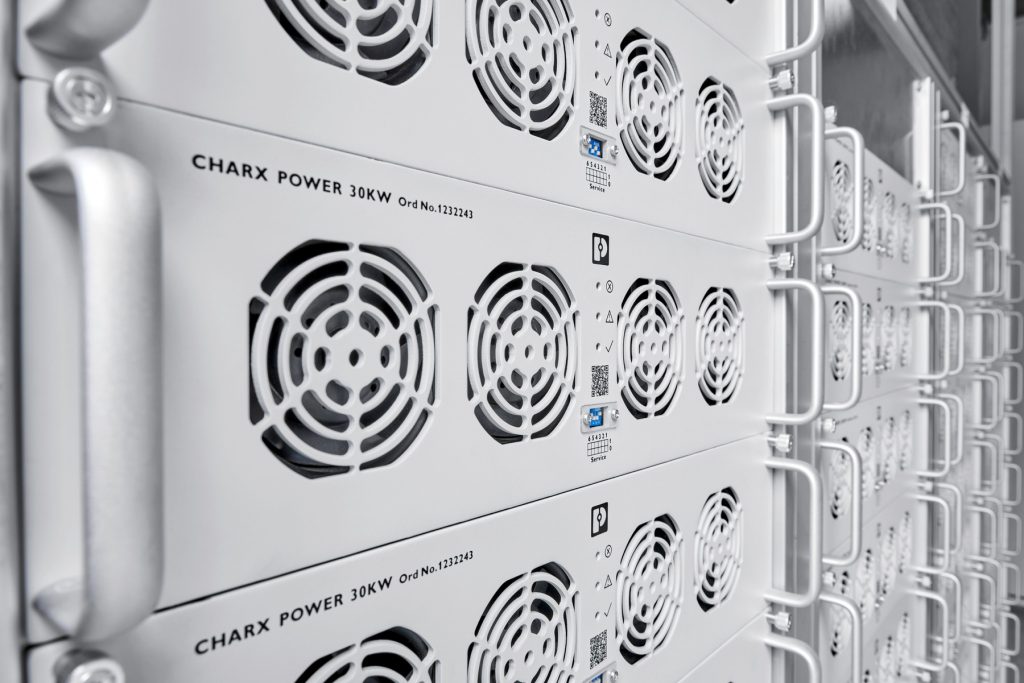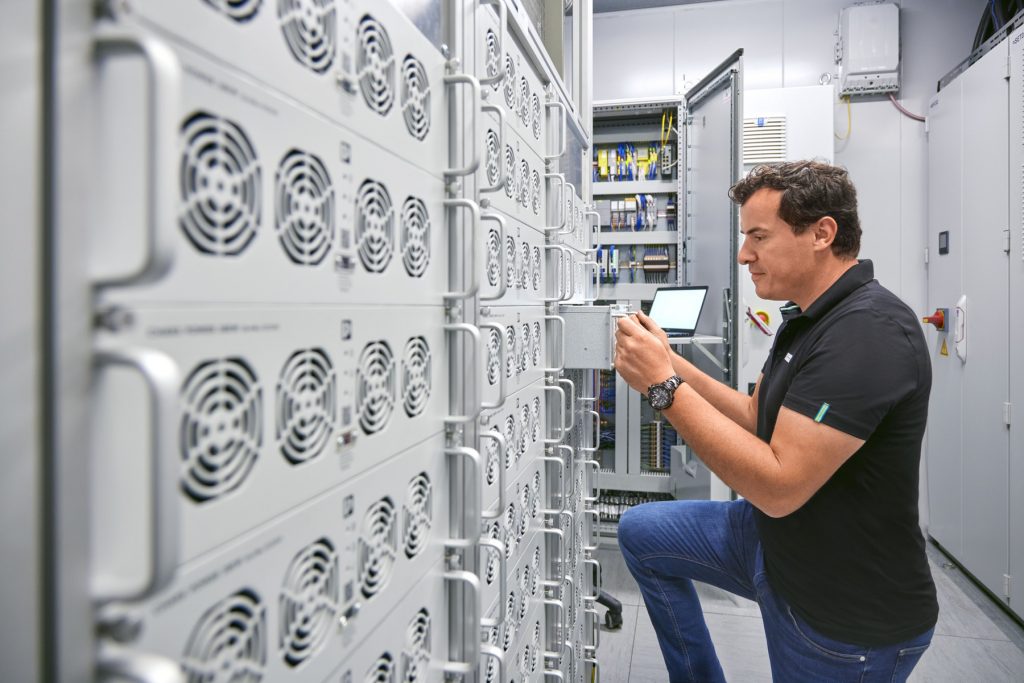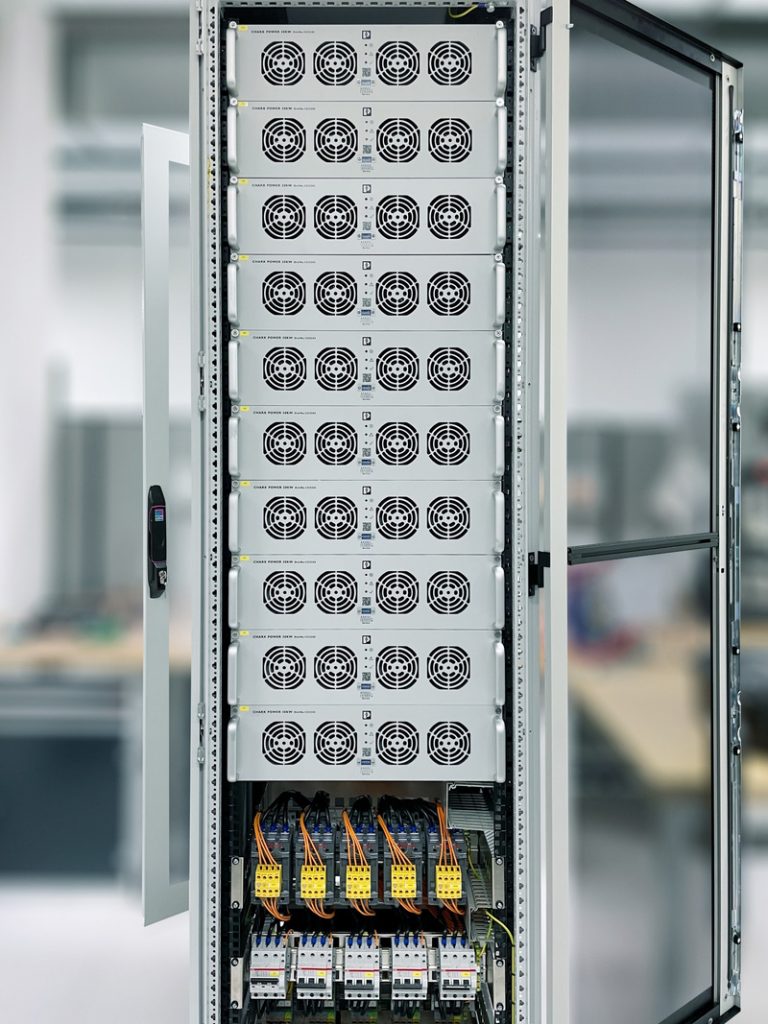Green electricity from wind and solar power can be abundant or scarce. Power-to-X technologies store this energy as electrochemically produced hydrogen, which is converted back into electricity in fuel cells. A modular solution with AC/DC converters supports various topologies for supplying electrolysis cells with direct current, simplifying maintenance and enhancing the availability and service life of electrolysis stacks.
The vision of an All Electric Society relies on affordable, renewable electricity. Wind and solar power are crucial but volatile, necessitating storage solutions. Future power grids will use pumped storage plants and battery storage systems to balance generation and consumption, though these aren’t suitable for long-term storage of large quantities of surplus electricity.
Power-to-X technologies can be used to store surplus electricity long-term by splitting water into hydrogen and oxygen via electrolysis. These can be converted into chemicals or fuels, or the hydrogen produced can be stored and later converted back into electricity in gas-fired power plants or fuel cells. Direct current through an electrolysis cell produces hydrogen at the cathode and oxygen at the anode, separated by a membrane to prevent reaction. The gases are vented off separately.

Modular concepts for electrolysis cells and power supply
Today’s electrolyzers are modular, with cells arranged in stacks, achieving powers from 10 kW to several MW. Larger plants, up to gigawatt scale, interconnect dozens or hundreds of electrolyzers. This modularity allows easy scalability and simplifies mass production. Designing a modular power supply for electrolyzers is ideal.
Scalable alternative to monolithic large-scale converters
All electrolyzers need direct current, so AC from the power grid must be converted by AC/DC converters. The cell voltage (1.6 to 2 V) must be maintained for the electrolytic process. Often, large monolithic converters are used, but a modular supply concept like the CHARX power system from Phoenix Contact offers an alternative. CHARX AC/DC converters convert AC to DC with the required voltage, ensuring high-quality electrical energy by reducing grid-side harmonics and the DC ripple is a maximum of just 1.5%. They also prevent short-term voltage dips and peaks.

Megawatt electrolyzer manufacturers impressed by modular supply concept
Phoenix Contact has implemented this concept in several electrolysis projects, equipping containerized units with modular rectifier units based on AC/DC converters. This modularized approach allows for standardized control cabinets that are adaptable to the power needs of each electrolysis module. Manufacturers were impressed by the technical details, such as integrated condition monitoring, long service life, easy maintenance, and high efficiency of the converters.
High-level efficiency and easy-to-integrate condition monitoring
Charx AC/DC converters, typically using IGBT technology with a 30 kW output, are highly efficient (up to 96%) and superior to monolithic converters. They offer a controllable DC output voltage range of 30 to 1,000 V, adaptable to various electrolysis stacks. Both voltage and current can be ramped up slowly. These converters provide internal electrical isolation between AC and DC grids, crucial for many electrolyzers. Charx converters with 20 kW output using SiC power semiconductors can achieve 97% efficiency, further reducing waste heat.
PLCnext Control devices from Phoenix Contact are ideal for control applications, offering library elements for simplified programming, flexible voltage and current control, and easy data integration for condition monitoring. Charx converters feature an openly accessible bus system. The modular power supply approach benefits electrolyzer manufacturers, allowing scalable green hydrogen production from pilot to megawatt plants.

Higher availability of converters and electrolyzer
Charx rectifiers optimize partial load operation by allowing parallel converters to be partially switched off, ensuring the remaining ones operate at optimal efficiency. This extends the service life by evenly reducing operating hours. Alternating the operation of converters also aids maintenance planning and prevents uneven loading
The concept benefits maintenance and servicing. Small-format modules can be easily kept as spares, and integrated condition monitoring alerts operators when replacements are needed. Modules can be replaced with standard tools while others continue to supply the electrolyzer, increasing system availability. Only during full-load operation is a slight reduction in supply noticeable when a module is replaced.
If a large monolithic converter fails, the entire electrolysis plant it supplies will stop. Replacement converters must be custom-made, causing the plant to be down for weeks and resulting in high yield losses.
Large megawatt converters supply multiple electrolysis stacks with the same voltage, but variations in stacks can cause issues. If one stack has a problem, it can affect the entire system. In contrast, using Charx modules allows individual stacks to be isolated and checked without shutting down the whole system, ensuring the remaining stacks continue to operate.
Using 19-inch modules may require more space and higher initial investment than large-scale converters. However, their advantages—higher availability, lower maintenance costs, and efficiency gains, especially in partial load operation—quickly offset these drawbacks.
Read more about AC/DC converters.

